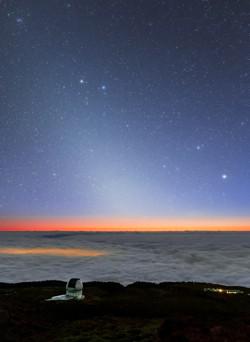Glossary term: Zodiacal Light
Description: Within the Solar System, planets and other bodies mostly orbit within the plane of the ecliptic. Interplanetary dust in our cosmic neighborhood is also concentrated near that plane. Some light from the Sun is reflected by those interplanetary dust grains in the ecliptic towards Earth. In principle, that produces a faint glowing ribbon across the night sky, along the Zodiac – the region in the night sky close to the ecliptic. In practice, that glow is only visible with the naked eye to the east shortly before sunrise or to the west shortly after sunset, only close to the horizon, and only from a naturally dark observing location. That visible part of the glow is the zodiacal light: a diffuse glowing region shaped like a rounded, elongated triangle that reaches from the horizon a short way along the ecliptic.
Related Terms:
See this term in other languages
Term and definition status: This term and its definition have been approved by a research astronomer and a teacher
The OAE Multilingual Glossary is a project of the IAU Office of Astronomy for Education (OAE) in collaboration with the IAU Office of Astronomy Outreach (OAO). The terms and definitions were chosen, written and reviewed by a collective effort from the OAE, the OAE Centers and Nodes, the OAE National Astronomy Education Coordinators (NAECs) and other volunteers. You can find a full list of credits here. All glossary terms and their definitions are released under a Creative Commons CC BY-4.0 license and should be credited to "IAU OAE".
Related Media
Zodiacal Light over GTC Observatory
Credit: Amirreza Kamkar/IAU OAE
License: CC-BY-4.0 Creative Commons Attribution 4.0 International (CC BY 4.0) icons









